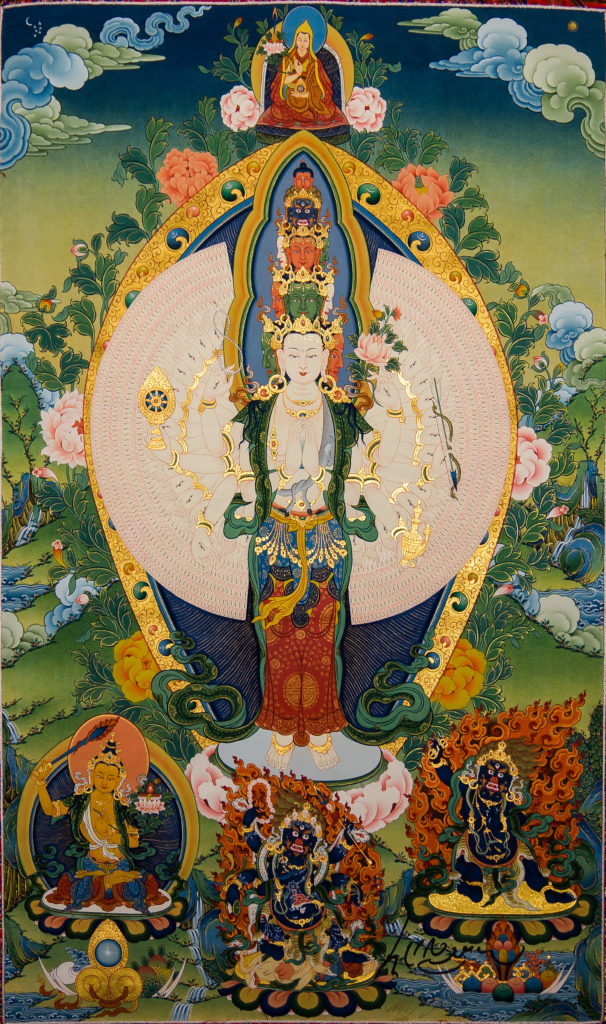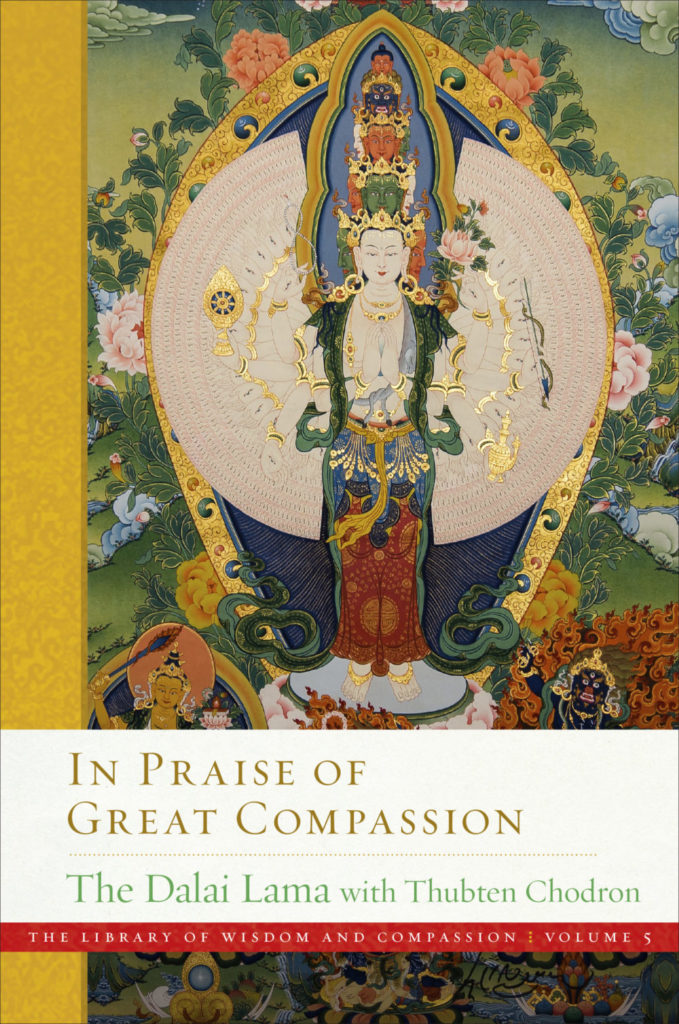 The word “bodhicitta” has two syllables, bodhi and citta. Bodhi means awakened or enlightened, and citta means mind. What type of mind? There are two types of mind: primary consciousnesses and mental factors. Primary consciousnesses know the general nature of an object, be it an object of sight, sound, smell, taste, or touch, or a mental object. Auxiliary mental factors know the specifics of the object. As a primary consciousness, bodhicitta focuses on the general nature of its object, which in this case is bodhi. “Bodhi” implies both purification and realization. To show this, Tibetan translators translated “bodhi” or “awakening” as byang chub (pronounced jang chup) in Tibetan. Byang indicates purification; we can understand that through purification of all mental obscurations it’s possible for the mind to directly know all phenomena. Chub indicates enhancing our good qualities so we can attain that state. In this way byang chub connotes that the awakening that comes about by completing the purification process is omniscience—buddhahood with the four buddha bodies.
The word “bodhicitta” has two syllables, bodhi and citta. Bodhi means awakened or enlightened, and citta means mind. What type of mind? There are two types of mind: primary consciousnesses and mental factors. Primary consciousnesses know the general nature of an object, be it an object of sight, sound, smell, taste, or touch, or a mental object. Auxiliary mental factors know the specifics of the object. As a primary consciousness, bodhicitta focuses on the general nature of its object, which in this case is bodhi. “Bodhi” implies both purification and realization. To show this, Tibetan translators translated “bodhi” or “awakening” as byang chub (pronounced jang chup) in Tibetan. Byang indicates purification; we can understand that through purification of all mental obscurations it’s possible for the mind to directly know all phenomena. Chub indicates enhancing our good qualities so we can attain that state. In this way byang chub connotes that the awakening that comes about by completing the purification process is omniscience—buddhahood with the four buddha bodies.
Similarly, Tibetan translators rendered the word “buddha” as sangs rgyas (pronounced sang gyey). Sangs means to eliminate, and refers to the eradicating of all faults and obscurations, and rgyas means to expand, in the sense of knowing all phenomena and actualizing all excellent qualities. Someone who has done this is sangs rgyas, or buddha.
Looking at the words byang chub and sangs rgyas, we see that they have similar meanings: both byang and sangs portray the purification of all obscurations, while both chub and rgyas indicate the expansion of good qualities and the development of all realizations, especially the direct realization of emptiness. This realization of emptiness is common to āryas of all three vehicles—the Śrāvaka, Solitary Realizer, and Bodhisattva Vehicles, each of which has its own awakening. Due to how śrāvakas, solitary realizers, and bodhisattvas practice before attaining their respective awakenings, there are differences in these three types of awakening. In the present case, “bodhi” refers to Mahāyāna bodhi or great awakening, so byang indicates the purification of both afflictive obscurations and cognitive obscurations, and chub is a buddha’s realization of ultimate reality in which meditative equipoise and post-meditative realization cannot be differentiated. A buddha’s awakening has the ability to simultaneously remain in the union of meditative equipoise and post-meditative realization until the end of space; unlike sentient beings, buddhas are omniscient and can directly perceive all veiled truths and ultimate truths simultaneously.
Bodhicitta is a primary mental consciousness. As such, it is accompanied by (is concomitant with) various mental factors, a principal one being the aspiration to attain full awakening. How does this aspiration arise? Contemplation of the kindness of sentient beings and their duḥkha in saṃsāra causes great compassion, which is a mental factor wishing sentient beings to be free from suffering. The observed object of compassion is sentient beings. Strong meditation on great compassion causes the aspiration to benefit sentient beings. This aspiration leads us to examine how best to benefit sentient beings, and we conclude that it is through attaining the qualities of a buddha. Thus the aspiration for full awakening is born. This aspiration accompanies the primary mind of bodhicitta. The observed object of bodhicitta is bodhi—our own full awakening. Bodhicitta is directed toward full awakening because we want to work for the welfare of all sentient beings by attaining full awakening. Wisdom is the force that will purify our mind and transform it into the fully awakened mind of a buddha. The observed object of this wisdom is emptiness.
"Wisdom is the force that will purify our mind and transform it into the fully awakened mind of a buddha."
To have the aspiration for full awakening, we have to understand what we are aspiring for, and to do this we first need to be convinced of the possibility of attaining true cessation, nirvāṇa. This returns us to the topic of the mind’s nature being pure and the afflictions being adventitious, which was discussed in an earlier volume. This, in turn, leads us to investigate the ultimate nature of the mind, through which we come to understand and then have an inferential realization of emptiness. Sharp-faculty practitioners generate bodhicitta on the basis of an inferential realization of emptiness that confirms the possibility of attaining full awakening. Their bodhicitta is especially firm and cannot degenerate because it is based on reasoning. Modest-faculty practitioners, inspired by their teachers, past practitioners, and the scriptures, assume that awakening is possible. With this vague understanding of awakening, they generate bodhicitta. Because their bodhicitta is based on faith, it is not firm and is vulnerable to degeneration.
In the Ornament of Clear Realizations Maitreya describes twenty-two types of bodhicitta that will be explained in a later chapter. Practitioners on the initial level of the path of accumulation have earth-like bodhicitta, which may degenerate so that the practitioner loses his bodhicitta and relapses to the state of a non-bodhisattva. However, gold-like bodhicitta, attained on the middle level of the path of accumulation, is stable and cannot degenerate. Bodhicitta divorced from the wisdom realizing emptiness cannot develop beyond the initial level of the path of accumulation; thus it is important to further our understanding of emptiness while we also create the causes to generate bodhicitta.
This wisdom mind that focuses on bodhi is completely developed at buddhahood. To arrive at the state of mental enrichment indicated by chub, we must understand the observed object of bodhicitta—full awakening. The potential to attain full awakening is not something that must be newly generated; it is an innate quality of our mind present from beginningless time. The Buddha said (AN 1.51):
This mind, O monastics, is luminous, but it is defiled by adventitious defilements.
And Maitreya said in the Sublime Continuum (RGV 1.50):
The pollutants are adventitious; the good qualities exist innately.
Dharmakīrti makes a similar statement (PV 2.208ab):
The nature of the mind is clear light;
the defilements are adventitious.
Both of these masters emphasize two reasons why pollutants can be eliminated from the mind. First, there exist strong counterforces capable of destroying the pollutants. Second, the nature of the mind is clear light—that is, the pollutants do not abide in the nature of the mind. The ability to cognize and understand objects is the innate nature of mind. When the obscurations are overcome and this ability is perfected and focused on worthwhile objects, the mind is purified and all obscurations removed. At that time, our mind will become the omniscient mind of a buddha.
If the ability to realize something is in the nature of the mind, why doesn’t our present mind realize all existents? Because it is polluted by obscurations. While chub indicates enriching the mind with realizations, to arrive at the state of perfect enrichment or realization, total purification is necessary. That is, purification must happen for enrichment to come about. Thus byang comes first, followed by chub in the word byang chub—the Tibetan word for awakening—because without purification there is no possibility of knowing all objects.
However, saying that the ability to cognize and understand that an object—even an object such as the emptiness of inherent existence—is an innate quality of the mind does not mean that we can sit back and relax and awakening will come to us without effort. Bringing to fruition the two aspirations associated with bodhicitta involves effort and diligence because serenity and insight must be cultivated and unified in order to nonconceptually realize ultimate bodhicitta—the wisdom directly realizing emptiness. Only that wisdom has the capacity to remove all obscurations from the mind in such a way that they can never reappear.
"Only that wisdom has the capacity to remove all obscurations from the mind in such a way that they can never reappear."
 In Praise of Great Compassion, the fifth volume of the Library of Wisdom and Compassion, continues the Dalai Lama’s teachings on the path to awakening. While previous volumes focused on our present situation and taking responsibility for creating the causes of happiness, this volume concerns opening our hearts and generating the intention to make our lives meaningful by benefiting others.
In Praise of Great Compassion, the fifth volume of the Library of Wisdom and Compassion, continues the Dalai Lama’s teachings on the path to awakening. While previous volumes focused on our present situation and taking responsibility for creating the causes of happiness, this volume concerns opening our hearts and generating the intention to make our lives meaningful by benefiting others.
We are embedded in a universe with other living beings, all of whom have been kind to us in one way or another. More than any other time in human history, we depend on one another to stay alive and flourish. When we look closely, it becomes apparent that we have been the recipient of great kindness. Wanting to repay others’ kindness, we cultivate a positive attitude by contemplating the four immeasurables of love, compassion, empathic joy, and equanimity, and the altruistic intention of bodhicitta. We learn to challenge the self-centered attitude that leads to misery and replace it with a more realistic perspective enabling us to remain emotionally balanced in good and bad times. In this way, all circumstances become favorable to the path to awakening.
| There are no products in your cart. |

